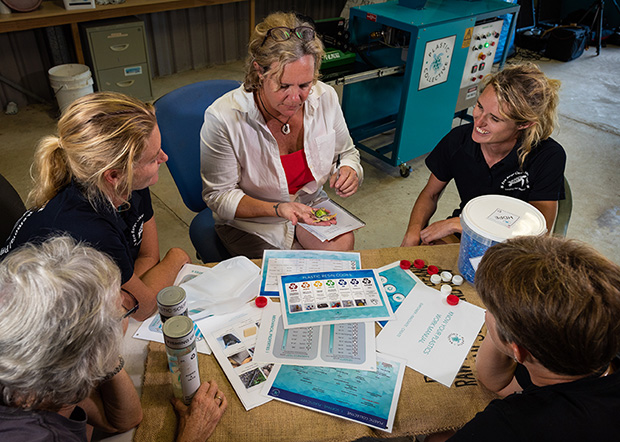Frequently Asked Questions
Need a quick answer? You’re in the right place.

General
What does Plastic Collective do, in one sentence?
We work with vulnerable communities to recover discarded plastic and with brands to turn that recovery into measurable, certified impact.
Where do you operate?
We have active hubs in Australia, Indonesia, Ghana, Vanuatu, Philippines, Malaysia, India, and Papua New Guinea.
Recycling & end-markets
Isn’t plastic recycling broken?
Traditional, centralised recycling often is. Our hubs are local, small-footprint, and focused on hard-to-reach leak zones—places mainstream systems miss. Every kilo is weighed, logged, and audited.
What happens to the plastic you collect?
Most is mechanically shredded into flakes and sold to local manufacturers for roof tiles, crates, or low-grade packaging. Some hubs pelletise HDPE/PP for higher-value extrusion.
Is it a closed loop?
When infrastructure allows, yes. HDPE flake goes back into bottle-to-bottle. Where infrastructure is limited, material is “up-cycled” (tiles, planks) or shipped to regional recyclers that meet Basel and Verra export rules.
Do you down-cycle anything?
Multi-layer sachets (flexible films) are compressed into boards—still better than landfill or open-burning, but we label them non-circulating in our reports.
Environmental & social impact
Do your credits reduce carbon, too?
Avoided-emission claims depend on plastic type and end-use. Some projects issue dual Verra Plastic + Carbon credits; others focus solely on waste reduction. Ask if carbon is part of your target.
How are waste-pickers paid?
Each collector is contracted through a local cooperative or social enterprise and earns above-market rates set against living-wage benchmarks. Payments are digital where possible for full traceability.
Verification & traceability
How do you prove the kilos?
Every batch is weighed on calibrated scales, photographed, geotagged, and uploaded to a Verra-approved ledger. Independent auditors sample 100 % of data annually.
Which standards do you follow?
All projects meet the Verra Plastic Waste Reduction Standard and carry OBP (Ocean-Bound Plastic) and Social+ social-safeguard certification. We also align with Ellen MacArthur Foundation principles.
Brands & EPR
What steps are involved in starting a plastic offset programme for brands?
The process is straightforward: first, measure your plastic footprint. Next, select a recovery plan that aligns with your goals. Then, fund certified projects in high-leakage regions where plastic is most likely to pollute. Finally, track and share your results through verified reports and impact stories. Here’s a step-by-step guide on how businesses can reduce plastic use and start offsetting effectively.
How does plastic offsetting improve brand trust and customer loyalty?
Shoppers and stakeholders want proof, not promises. By investing in certified plastic recovery, brands demonstrate accountability and authenticity, which strengthens reputation and customer trust. Verified action against plastic waste not only meets rising consumer expectations but also increases loyalty and long-term brand value. Learn more about the benefits of reducing plastic waste for businesses.
How can plastic offsetting support ESG and sustainability goals?
Plastic offsetting provides companies with verifiable data to meet ESG targets, strengthen annual reporting, and demonstrate real action against plastic waste. It also supports compliance with Extended Producer Responsibility (EPR) and builds credibility with investors, retailers, and eco-conscious customers. Discover how offsetting your brand’s plastic footprint can help achieve ESG goals.
Will credits satisfy my EPR obligation?
It depends on the jurisdiction. Regulators in parts of India, Indonesia, and Colombia accept credits recognised under Verra PWRS plus audit evidence. Check local guidance or talk to our policy team.
How do we talk about the impact without greenwashing?
We provide pre-approved claim language, seals, and data points that align with ISO 14021 guidance and local ad standards rules.
Can you calculate our plastic footprint?
Yes. Start with the Plastic Impact Plan (15 questions); we provide a baseline, reduction + recovery roadmap.
How can we communicate our impact in a way that grows the brand?
We help you turn verified recovery into brand trust. Through certified claims, impact visuals, and storytelling content, we equip your team to share real results on packaging, in-store, online, and in the boardroom. It’s not just good for the planet. It’s good for your brand’s credibility, loyalty, and long-term value, and if you’re ready to discuss your options, visit our brands page for more.
Individuals
I’m one person—does a small contribution help?
Absolutely. As little as USD 10/month funds the removal of 8–10 kg of plastic annually and provides steady income to local collectors. You’ll receive a monthly progress email and see your kilos grow on the dashboard. You can learn more about this on our Individuals page
What is a plastic offset programme?
A plastic offset programme allows businesses to balance their plastic footprint by funding the recovery of an equivalent amount of plastic from the environment. Instead of contributing to pollution, companies can directly support certified recovery projects that reduce waste, create fair jobs, and protect ecosystems. You can learn more about how these plastic offsetting schemes work for businesses
How does plastic offsetting help compare to recycling?
While recycling is important, it alone cannot keep up with the amount of plastic entering the environment. Plastic offsetting addresses the issue at the source by ensuring plastic waste is collected and recovered before it reaches oceans or landfills. It complements recycling by funding recovery where no recycling systems exist. Here’s a deeper look at why recycling alone isn’t enough and how offsetting makes a difference
How do I know my contribution is making a real impact?
All recovery efforts supported through Plastic Collective are independently verified under global standards such as Verra, OBP, and Social+. This ensures transparency, traceability, and accountability. Businesses receive audit-ready documentation, live dashboards, and certificates to show exactly how much plastic has been removed and where. That way, you know every contribution results in measurable, certified impact.
Community & projects
How can my village apply for support?
Complete this Questionnaire for your community review. We regularly assess communities seeking support and shortlist those we are able to support.
For more community information, email manager@plasticcollective.org
